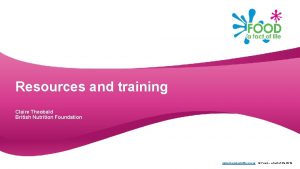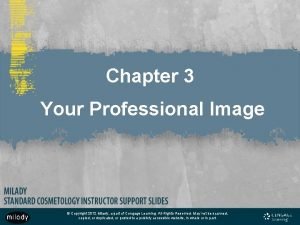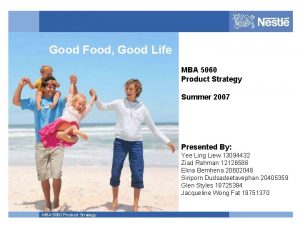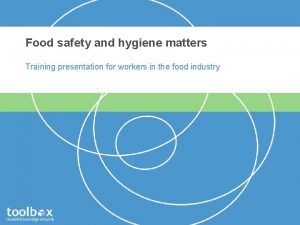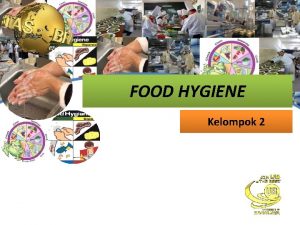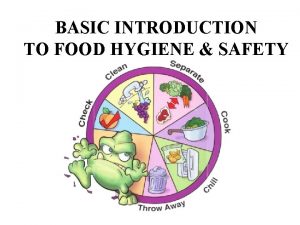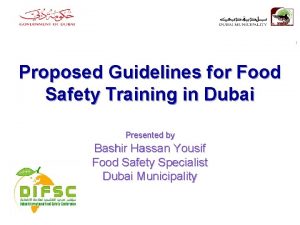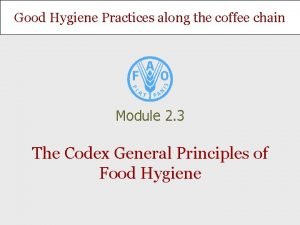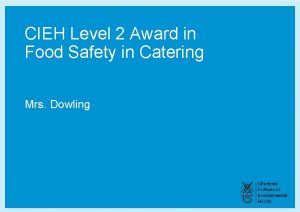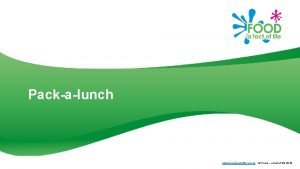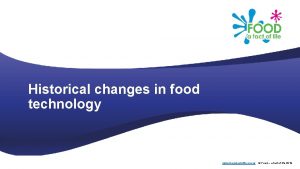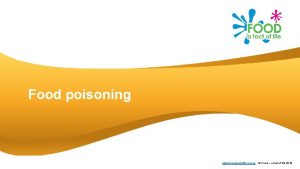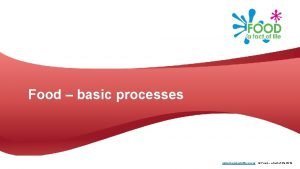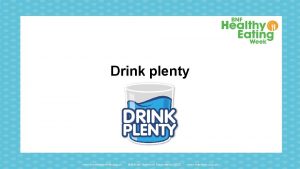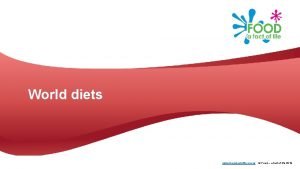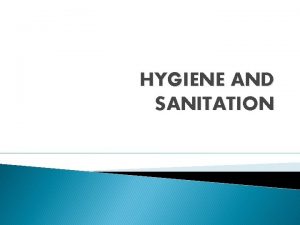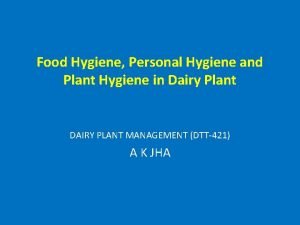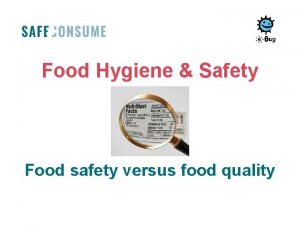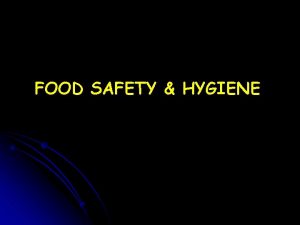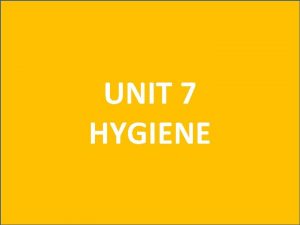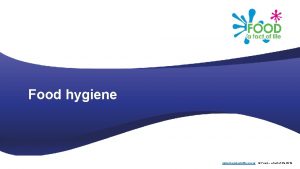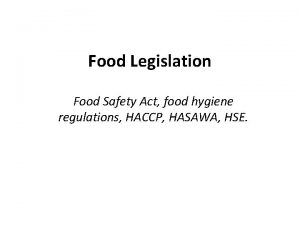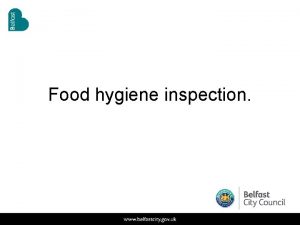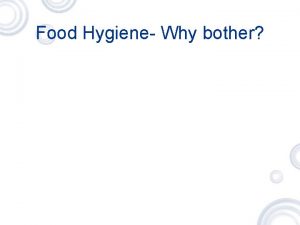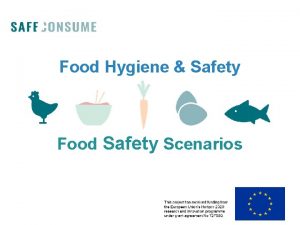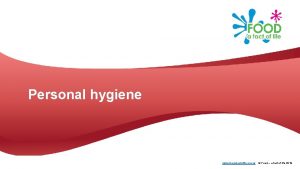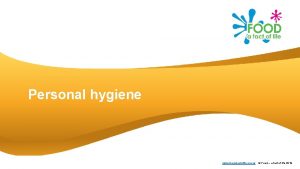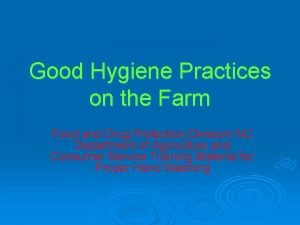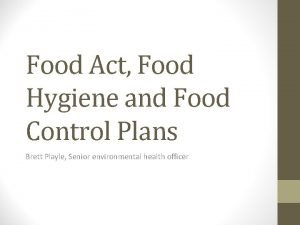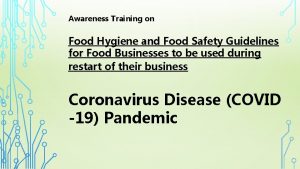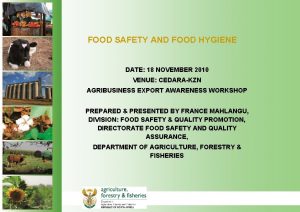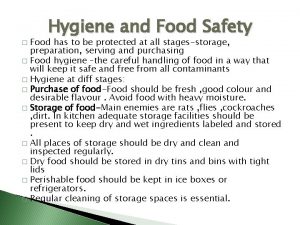Good food hygiene and safety practices www foodafactoflife




























- Slides: 28

Good food hygiene and safety practices www. foodafactoflife. org. uk © Food – a fact of life 2019

What will we be covering? • Why are good food hygiene and safety practices • • • important? Devising, implementing and monitoring procedures. Integrating food hygiene and safety into Schemes of Work, lessons and activities. Applying good food hygiene and safety knowledge and skills. Incorporating food hygiene and safety when assessing practical activities. Links to Food – a fact of life resources. Suggestions for further sources of information and support. www. foodafactoflife. org. uk © Food – a fact of life 2019

Food safety The World Health Organisation estimates that approximately 600 million, almost 1 in 10 people in the world, fall ill after eating contaminated food and 420, 000 die every year, resulting in the loss of 33 million healthy life years. Therefore, it is essential that all food handlers, whether they are cooking and serving food for consumers to purchase or cooking for themselves or their families at home, take the steps necessary to reduce the risk of food poisoning. This also relates to cooking in school! www. who. int Interesting research from the Food Standards Agency: The Food and You Survey Wave 4 www. foodafactoflife. org. uk © Food – a fact of life 2019

Why are good food hygiene and safety practices in school important? To prevent food poisoning – pupils, parents and staff. Teacher’s own indemnity. Greater emphasis on healthy eating and practical cookery in the curriculum. To ensure that pupils feel safe and are safe (Ofsted 2019), feel safe and secure (Estyn), and that school facilities are safe and secure for all (Education Scotland How good is our school? ). In Northern Ireland effective practice in care and welfare is demonstrated when there is a safe, secure environment for all members of the school community (etini). www. foodafactoflife. org. uk © Food – a fact of life 2019

Legal requirements When considering food safety in the classroom, teachers and schools must take into account: • • The Food Safety Act 1990 Health and safety at Work Regulations 1999 General Food Hygiene Regulations 1995 onwards The Control of Substances Hazardous to Health Regulations 2002 - Approved Code of Practice and Guidance, 2005. In England, there also recommendations from the Design and Technology Association: • BS 4163: 2014 Health and safety for design and technology in http: //bit. ly/1 Qnh. DUj For further information see the Food Standards Agency and Food Standards Scotland websites. schools and similar establishments. Code of practice. • Health and safety checklist for classrooms HSE. www. foodafactoflife. org. uk © Food – a fact of life 2019

Legal requirements Legally, a ‘food business’ must demonstrate due diligence. In the business world this would mean: A food business must be able to demonstrate that it has done everything within its power to safeguard consumer health. This equates to the classroom: A …………. must be able to demonstrate it has done everything in it’s power to safeguard ………… health. www. foodafactoflife. org. uk © Food – a fact of life 2019

Legal requirements – food handlers • Keep yourself clean. • Keep the workplace clean. • Protect food from contamination or anything that could cause harm. • Follow good personal hygiene practices e. g. hand washing. • Wear appropriate protective clothing. • Tell your employer (head teacher) if you are suffering from or are a carrier of a food-borne illness. www. foodafactoflife. org. uk © Food – a fact of life 2019

Food hygiene and safety qualifications It is not a legal requirement for a teacher of food and nutrition to hold a recognised and up-to-date food hygiene/safety qualification. However, some LAs (or a school’s own policy) may ask their teachers or a teacher in the school to have this. Having a food hygiene and safety certificate can: • make you feel more confident about cooking safely in • • your classroom; help ensure you have considered all possible risks; help ensure you demonstrate best practice; be useful to include in your risk assessment; add to your CPD. www. foodafactoflife. org. uk © Food – a fact of life 2019

Food safety policies and risk assessments – why are these necessary? Whilst carrying out a risk assessment for food activities is not a requirement in all countries of the UK, it is strongly advised. Risk assessments help to minimise the risks in practical work and can focus attention on what the hazards might be and how they can be prevented or reduced. In addition, poor hygiene and safety would be considered/noticed in an education inspection and drawn to the school’s attention. Food safety policies and risk assessments would help to ensure effective procedures are in place. Risk assessments could be for recipes, lessons and equipment. As well as ensuring pupil safety in the classroom, a food teacher’s role also includes the safe storage and handling of all ingredients including those that pupils bring with them from home. www. foodafactoflife. org. uk © Food – a fact of life 2019

Risk assessments You may think that you do a risk assessment every time you enter your classroom. However, risk assessments are formal activities and should follow five stages: 1. Look for the hazards. 2. Decide who might be harmed and how. 3. Evaluate the risks and decide whether the existing precautions are adequate or whether more should be done. 4. Record your findings. 5. Review your assessment and revise it if necessary. www. foodafactoflife. org. uk © Food – a fact of life 2019

Generic risk assessments These are usually available through Local Authorities but it is essential that schools adapt these to their own setting and account for any specific hazards. Example risk assessments for food work in schools along with other support for good food hygiene and safety practices is available on www. foodafactoflife. org. uk In England, Wales and Northern Ireland, generic risk assessments are also available from CLEAPSS. In Scotland, they are available from SSERC. Good food hygiene and safety practices www. foodafactoflife. org. uk © Food – a fact of life 2019

Implementing robust food hygiene and safety procedures General food hygiene and safety procedures • Establish cleaning schedules for the practical room; these should be monitored and reviewed. • Complete daily fridge temperature checks, record and monitor. • Check date marks on ambient, chilled and frozen food. Label open bottles and jars in the fridge with an ‘opened on date’ to ensure good stock management. • Ensure ingredients are stored correctly before and after use. • Avoid washing raw meat to prevent cross-contamination. • Use digital temperature probes to check the core temperature of food is at least 75°C (or 70°C for 2 minutes). www. foodafactoflife. org. uk © Food – a fact of life 2019

Implementing robust food hygiene and safety procedures General food hygiene and safety procedures • Make sure that hot food is cooled quickly and stored below 5°C within 1 -2 hours. • Ensure that finished dishes are stored appropriately in the food room until the end of the day. • Place any dishes not collected by pupils in food waste bins, after 48 hours or 24 hours for rice dishes. • Dispose of spare pupil ingredients – although this may seem wasteful, schools should not accept left over ingredients from pupils as the age/shelf life, provenance and safety cannot be assured. www. foodafactoflife. org. uk © Food – a fact of life 2019

Implementing robust food hygiene and safety procedures Measures to prevent cross-contamination of allergens and the risk of allergic reaction • Establish procedures to ensure that pupil and staff allergies and intolerances are known, recorded and reviewed regularly. • Store food containing allergenic ingredients separately. • Make sure equipment is used, cleaned and stored separately to prevent cross-contamination of allergens. • Make sure that staff and pupils are aware of the main 14 allergenic ingredients in recipes, food for tasting and investigations. FSA allergen menu chart www. foodafactoflife. org. uk © Food – a fact of life 2019

Implementing robust food hygiene and safety procedures Safe and hygienic procedures for tasting and testing • Ensure that staff and pupils are aware of allergenic ingredients in food provided for tasting activities or investigations. • Establish clear guidelines for hygiene standards when sampling food and drink, e. g. no ‘double dipping’ or licking fingers. www. foodafactoflife. org. uk © Food – a fact of life 2019

Implementing robust food hygiene and safety procedures Adopt a regular routine for getting ready to cook (modelled by all staff) • Place ingredients in the food room at the start of the day and store in the correct place. • Remove blazers, and jumpers (if appropriate), on entering the food room. • Remove nail varnish and jewellery. • Keep school bags away from the food area. • Tie up long hair, ensuring it is not hanging down. • Secure long head scarves or coverings. • Roll up long sleeves. • Thoroughly wash and dry hands. • Put on a clean apron. www. foodafactoflife. org. uk © Food – a fact of life 2019

Model exemplary practical skills and food hygiene and safety practices • Demonstrate safe use and storage of electrical equipment. • Use clean, tidy and effective procedures for practical activities, including demonstrations. • Demonstrate the correct use of equipment for practical activities to prevent cross-contamination, e. g. a red chopping board for raw meat. • Use oven gloves when handling hot items or taking items in and out of the oven. www. foodafactoflife. org. uk © Food – a fact of life 2019

Top tip – pre-print labels for dishes Pre-print name labels for dishes made – this helps manage the food stored in your fridges but also gives pupils and parents important storage, cooking and allergen information. The information on the label could include: • name, date and class/year group; • cooking/reheating and storage instructions; • allergens. Name: Date: Form: Lamb Rogan josh: Store in a refrigerator and consume within 48 hours (24 hours if served with rice). To reheat, place in a saucepan, cover with a lid and heat for 15 -20 minutes or place in a suitable container and microwave on full power. Check piping hot before serving. Allergens: mustard Example food labels www. foodafactoflife. org. uk © Food – a fact of life 2019

Top tip – use a pot of water to take the fridge temperature Place a small pot of water in the fridge and use a digital thermometer to record the temperature of the fridge each day. Taking the temperature of the water provides a more accurate reflection of the temperature of the food and drink in the fridge. www. foodafactoflife. org. uk © Food – a fact of life 2019

More top tips • Have a supply of hair bands, nail varnish remover/plastic gloves and spare aprons. • If there is a ‘bottleneck’ at the hand wash station, divide the class in half. Task one half to wash their hands and the other to read through the recipe they are going to be making. The two halves should then swap activities. • Use a rack to store clean plastic chopping boards to enable them to air dry fully and prevent mould and the multiplication of bacteria. www. foodafactoflife. org. uk © Food – a fact of life 2019

Record keeping – part of due diligence It is important to keep a food hygiene and safety file in the food room with the following up to date documents: • daily fridge/freezer temperature record sheets; • risk assessments; • cleaning schedules; • COSHH record sheets (where appropriate); • a list of pupil’s special dietary requirements, especially allergies; • food hygiene and health and safety training certificates; • other departmental food policies/letters to parents, e. g. provision of ingredients/storage of ingredients/food at school. Good food hygiene and safety practices www. foodafactoflife. org. uk © Food – a fact of life 2019

Integrating food hygiene and safety into Schemes of Work, lessons and activities Build in activities that will allow theory to be applied, for example: • Demonstrate how the use of time plans, flow charts, and quality control charts can be used to apply theory to practical activities. • Challenge pupils to list food hygiene and health and safety risks during practical activities and/or on recipes. • Set pupils the task/challenge to be ‘Food safety inspectors’ during practical activities. Reverse the role next lesson. www. foodafactoflife. org. uk © Food – a fact of life 2019

Integrating food hygiene and safety into Schemes of Work, lessons and activities Build in activities that will allow theory to be applied, for example: • Remind pupils that not all bacteria is pathogenic (harmful) and use recipes that demonstrate how bacteria is used in food production, e. g. yogurt or bread. • Teach the 4 Cs – cleaning, cooking, cross-contamination and chilling through watching Bacteria bites business • Task the pupils to record the food hygiene skills and knowledge they have learnt. www. foodafactoflife. org. uk © Food – a fact of life 2019

Other activities that allow theory to be applied www. foodafactoflife. org. uk © Food – a fact of life 2019

Incorporating food hygiene and safety when assessing practical activities Assessment procedures should reflect stated learning objectives/intent, demonstrate progression and provide constructive feedback to pupils. Food hygiene and safety should be integral when assessing practical activities. www. foodafactoflife. org. uk © Food – a fact of life 2019

Sources of information and support Characteristics of good practice in teaching food and nutrition education (secondary) A guide to help food and nutrition teachers across the UK to become even better teachers. The guide covers 11 characteristics including Good food hygiene and safety practices. 'Characteristics' guide There is also a free online training course based on the ‘Characteristics’ guide. For more information, go to: www. foodafactoflife. org. uk There is also a free online FFL Food spoilage, hygiene and safety course. www. foodafactoflife. org. uk © Food – a fact of life 2019

Further sources of information and support • CLEAPSS www. cleapss. org. uk • Design and Technology Association www. data. org. uk • Food Standards Agency www. food. gov. uk • Food Standards Agency student resources for colleges www. food. gov. uk • Food Standards Scotland www. foodstandards. gov. scot • Food Standards Scotland education resources www. foodstandards. gov. scot • Food teaching in schools: A framework of knowledge and skills www. foodafactoflife. org. uk • Health and Safety Executive www. hse. gov. uk/scotland • NHS Choices www. nhs. uk • NHS inform www. nhsinform. scot • SSERC https: //www. sserc. org. uk www. foodafactoflife. org. uk © Food – a fact of life 2019

Good food hygiene and safety practices For further information, go to: www. foodafactoflife. org. uk © Food – a fact of life 2019
 Explore food.foodafactoflife
Explore food.foodafactoflife Good thoughts good deeds good words
Good thoughts good deeds good words Hi good afternoon how are you
Hi good afternoon how are you Buenas tardes good afternoon
Buenas tardes good afternoon If you are
If you are Hello teacher good afternoon
Hello teacher good afternoon Food safety food security
Food safety food security Chapter 3 professional image
Chapter 3 professional image Good food good life
Good food good life Flipchart on safety practices and sports injury management
Flipchart on safety practices and sports injury management Food hygiene matters
Food hygiene matters Pengertian food hygiene
Pengertian food hygiene Introduction of food hygiene
Introduction of food hygiene Food hygiene training in dubai
Food hygiene training in dubai Definition of food hygiene
Definition of food hygiene Food hygiene definition
Food hygiene definition Cieh level 2 award in principles of haccp
Cieh level 2 award in principles of haccp Big data: issues, challenges, tools and good practices
Big data: issues, challenges, tools and good practices Unit 2 food food food
Unit 2 food food food Food chain sequence
Food chain sequence Recipe modification
Recipe modification Foodafactoflife
Foodafactoflife Www.foodafactoflife.org.uk
Www.foodafactoflife.org.uk Wacky warning labels
Wacky warning labels Foodfactforlife
Foodfactforlife Foodafactof life
Foodafactof life Foodafactoflife
Foodafactoflife Www.foodafactoflife.org.uk
Www.foodafactoflife.org.uk Foodafactoflife
Foodafactoflife
